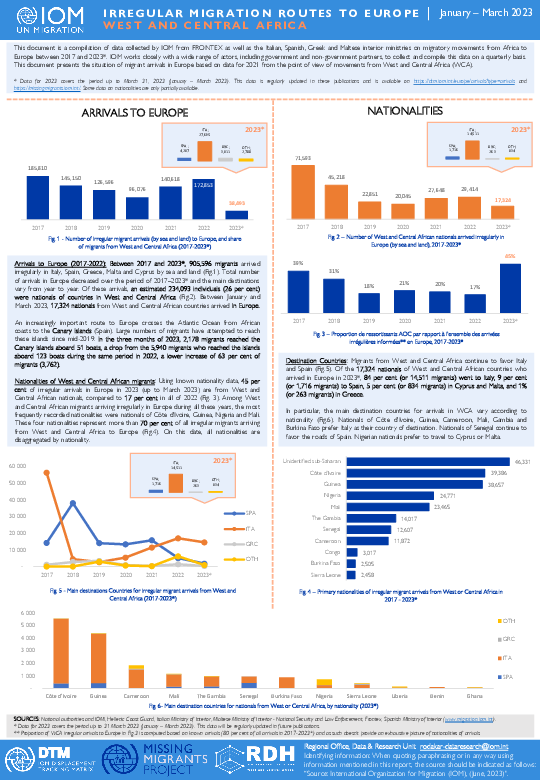-
Countries
-
Data and Analysis
-
Special Focus
-
Crisis Responses

Contact
DTMUkraine@iom.int
Language
English
Location
Ukraine
Period Covered
May 11 2023
Jun 14 2023
Activity
- Survey
Between 11 May and 14 June 2023, the International Organization for Migration (IOM) conducted the 13th round of a highly representative assessment of the general population in Ukraine to gather information on displacement, mobility flows, intentions, and conditions to inform targeted assistance to the war-affected population carried out in two stages. From Round 13 onwards, the survey methodology has been adapted to produce representative quarterly data at the oblast level. This round also introduces a new set of questions on durable solutions to internal displacement aligned with the criteria proposed by the Inter-Agency Standing Committee Framework on Durable Solutions for IDPs. The goal of the General Population Survey is to facilitate evidence-based decision-making on strategic, technical, and programmatic aspects of the response and recovery efforts in Ukraine, including the Government of Ukraine. The geographical scope of the assessment covers the entire territory of Ukraine, excluding the Autonomous Republic of Crimea and areas of Donetska, Luhanska, Khersonska and Zaporizka Oblasts under temporary military control of the RF. The General Population Survey was constructed through a random-digit-dial (RDD) approach, and 5,297 unique and anonymous respondents aged 18 and over were interviewed using the computer-assisted telephone interview (CATI) method. The estimates are based on UNFPA population data for Ukraine (last available data as of 14 November 2022), agreed as a common population baseline by the humanitarian community. Those currently outside Ukraine were not interviewed.
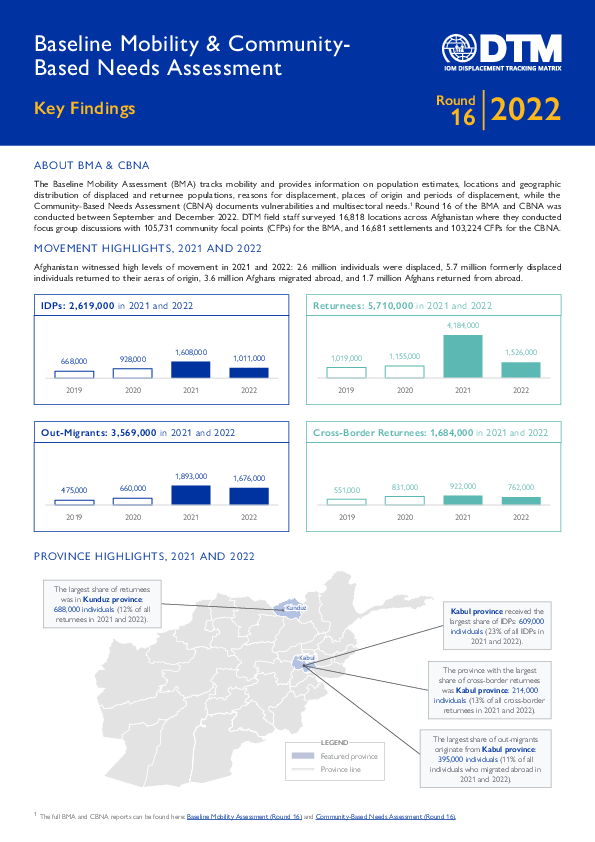
Contact
DTMAfghanistan@iom.int
Language
English
Location
Afghanistan
Period Covered
Sep 01 2022
Dec 31 2022
Activity
- Mobility Tracking
- Baseline Assessment
DTM has been conducting the Baseline Mobility Assessment (BMA) in Afghanistan since 2016 to track mobility, provide information on population estimates, locations and geographic distribution of displaced and returnee populations, reasons for displacement, places of origin and periods of displacement. The Community-Based Needs Assessment (CBNA) provides a comprehensive overview of the evolving vulnerabilities and multisectoral needs in communities hosting internally displaced persons (IDPs) and returnees from abroad.
Data is collected at the settlement level through focus group discussions with community focal points and direct observation. The figures presented in the report are estimates provided by community focal points.
The key findings report summarizes the results of Round 16 (Sep to Dec 2022) of the BMA and CBNA, focusing on the 2021-to-2022 period.
The full reports can be found here: Baseline Mobility Assessment and Community-Based Needs Assessment.
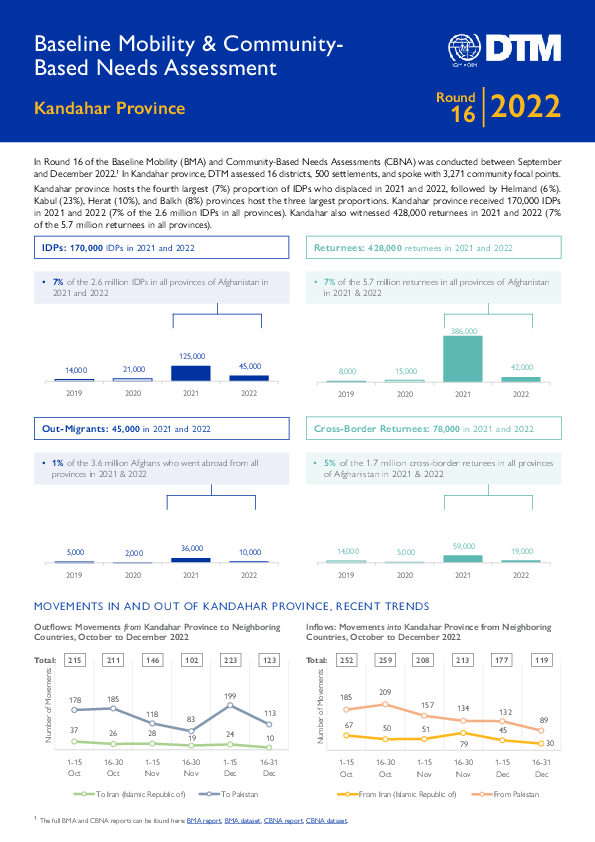
Contact
DTMAfghanistan@iom.int
Language
English
Location
Afghanistan
Period Covered
Sep 01 2022
Dec 31 2022
Activity
- Mobility Tracking
- Site Assessment
- Baseline Assessment
DTM has been conducting the Baseline Mobility Assessment (BMA) in Afghanistan since 2016 to track mobility, provide information on population estimates, locations and geographic distribution of displaced and returnee populations, reasons for displacement, places of origin and periods of displacement. The Community-Based Needs Assessment (CBNA) provides a comprehensive overview of the evolving vulnerabilities and multisectoral needs in communities hosting internally displaced persons (IDPs) and returnees from abroad.
Data is collected at the settlement level through focus group discussions with community focal points and direct observation. The figures presented in the report are estimates provided by community focal points.
This factsheet delves into the key findings in Kandahar province using the latest results from Round 16 (Sep to Dec 2022) of the BMA and CBNA, focusing on the 2021-to-2022 period.
The full report can be found here: Baseline Mobility Assessment and Community-Based Needs Assessment.
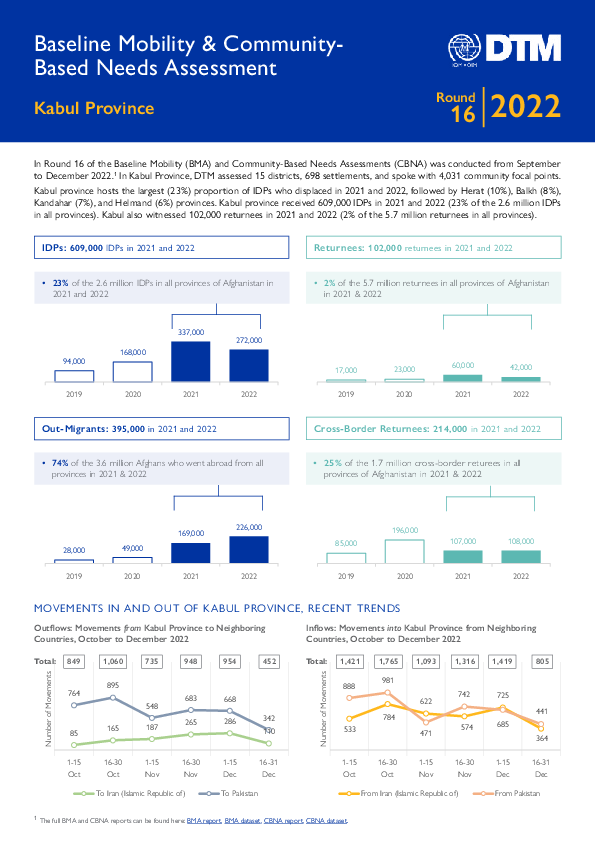
Contact
DTMAfghanistan@iom.int
Language
English
Location
Afghanistan
Period Covered
Sep 01 2022
Dec 31 2022
Activity
- Mobility Tracking
- Site Assessment
- Baseline Assessment
DTM has been conducting the Baseline Mobility Assessment (BMA) in Afghanistan since 2016 to track mobility, provide information on population estimates, locations and geographic distribution of displaced and returnee populations, reasons for displacement, places of origin and periods of displacement. The Community-Based Needs Assessment (CBNA) provides a comprehensive overview of the evolving vulnerabilities and multisectoral needs in communities hosting internally displaced persons (IDPs) and returnees from abroad.
Data is collected at the settlement level through focus group discussions with community focal points and direct observation. The figures presented in the report are estimates provided by community focal points.
This factsheet delves into the key findings in Kabul province using the latest results from Round 16 (Sep to Dec 2022) of the BMA and CBNA, focusing on the 2021-to-2022 period.
The full report can be found here: Baseline Mobility Assessment and Community-Based Needs Assessment.

Contact
DTMAfghanistan@iom.int
Language
English
Location
Afghanistan
Period Covered
Sep 01 2022
Dec 31 2022
Activity
- Mobility Tracking
- Site Assessment
- Baseline Assessment
DTM has been conducting the Baseline Mobility Assessment (BMA) in Afghanistan since 2016 to track mobility, provide information on population estimates, locations and geographic distribution of displaced and returnee populations, reasons for displacement, places of origin and periods of displacement. The Community-Based Needs Assessment (CBNA) provides a comprehensive overview of the evolving vulnerabilities and multisectoral needs in communities hosting internally displaced persons (IDPs) and returnees from abroad.
Data is collected at the settlement level through focus group discussions with community focal points and direct observation. The figures presented in the report are estimates provided by community focal points.
This factsheet delves into the key findings in Herat province using the latest results from Round 16 (Sep to Dec 2022) of the BMA and CBNA, focusing on the 2021-to-2022 period.
The full report can be found here: Baseline Mobility Assessment and Community-Based Needs Assessment.
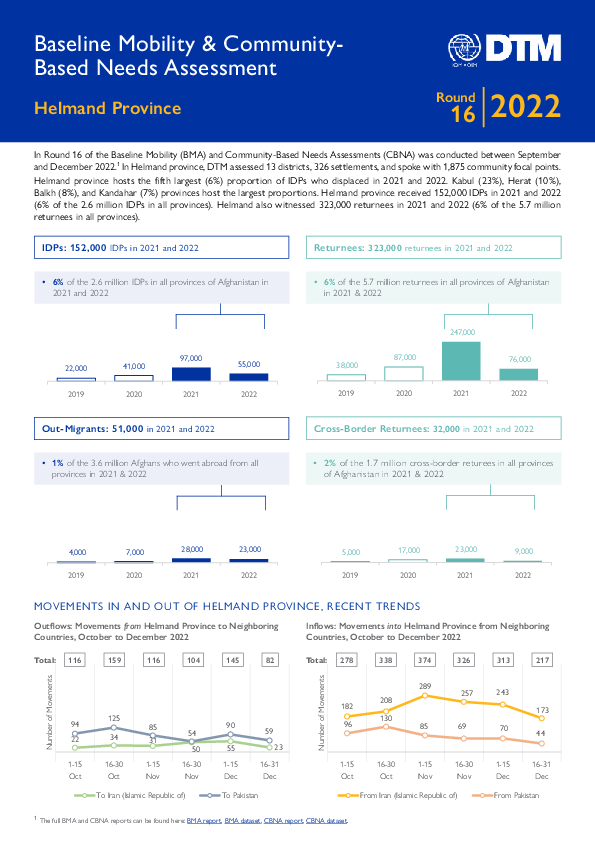
Contact
DTMAfghanistan@iom.int
Language
English
Location
Afghanistan
Period Covered
Sep 01 2022
Dec 31 2022
Activity
- Mobility Tracking
- Site Assessment
- Baseline Assessment
DTM has been conducting the Baseline Mobility Assessment (BMA) in Afghanistan since 2016 to track mobility, provide information on population estimates, locations and geographic distribution of displaced and returnee populations, reasons for displacement, places of origin and periods of displacement. The Community-Based Needs Assessment (CBNA) provides a comprehensive overview of the evolving vulnerabilities and multisectoral needs in communities hosting internally displaced persons (IDPs) and returnees from abroad.
Data is collected at the settlement level through focus group discussions with community focal points and direct observation. The figures presented in the report are estimates provided by community focal points.
This factsheet delves into the key findings in Helmand province using the latest results from Round 16 (Sep to Dec 2022) of the BMA and CBNA, focusing on the 2021-to-2022 period.
The full report can be found here: Baseline Mobility Assessment and Community-Based Needs Assessment.
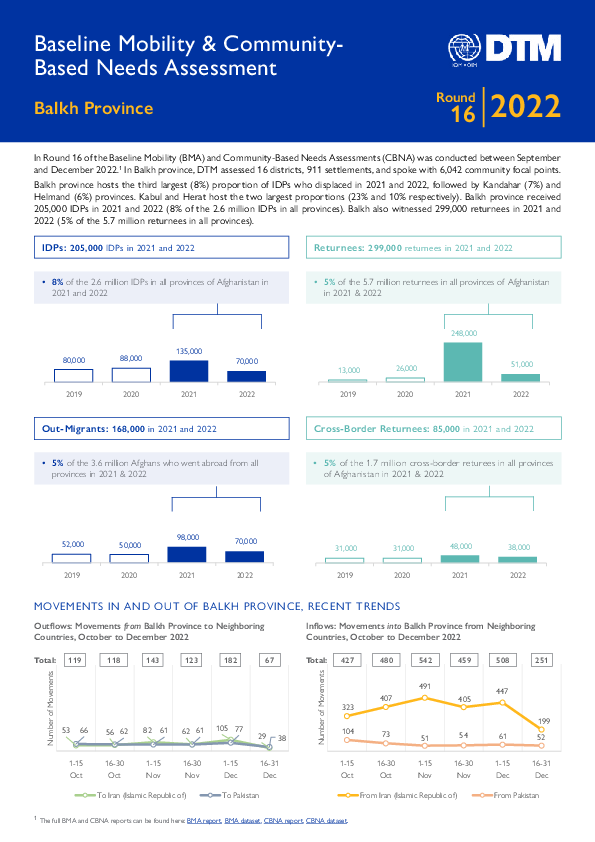
Contact
DTMAfghanistan@iom.int
Language
English
Location
Afghanistan
Period Covered
Sep 01 2022
Dec 31 2022
Activity
- Mobility Tracking
- Site Assessment
- Baseline Assessment
DTM has been conducting the Baseline Mobility Assessment (BMA) in Afghanistan since 2016 to track mobility, provide information on population estimates, locations and geographic distribution of displaced and returnee populations, reasons for displacement, places of origin and periods of displacement. The Community-Based Needs Assessment (CBNA) provides a comprehensive overview of the evolving vulnerabilities and multisectoral needs in communities hosting internally displaced persons (IDPs) and returnees from abroad.
Data is collected at the settlement level through focus group discussions with community focal points and direct observation. The figures presented in the report are estimates provided by community focal points.
This factsheet delves into the key findings in Balkh province using the latest results from Round 16 (Sep to Dec 2022) of the BMA and CBNA, focusing on the 2021-to-2022 period.
The full report can be found here: Baseline Mobility Assessment and Community-Based Needs Assessment.
This document is a compilation of data collected by IOM from FRONTEX as well as the Italian, Spanish, Greek and Maltese interior ministries on migratory movements from Africa to Europe between 2017 and March 2023. IOM works closely with a wide range of actors, including government and non-government partners, to collect and compile this data on a quarterly basis.
This document presents the situation of migrant arrivals in Europe based on data for 2021 from the point of view of movements from West and Central Africa (WCA).

Contact
DTM Europe, DTMMediterranean@iom.int
Language
English
Location
Sweden
Period Covered
Apr 03 2023
May 15 2023
Activity
- Survey
This is the Executive Summary in Swedish and English of the report available at this link.
This report is based on a survey developed by IOM to offer an overview of the living conditions, intentions, needs, and integration challenges of displaced persons from Ukraine1 in Sweden at the beginning of the second year of implementation of the temporary protection (TP) directive in the country.
Commissioned by the Swedish Government and coordinated by the Swedish Government’s Offices, it was conducted between April and mid-May 2023 online and through phone interviews to overcome potential biases and increase the strengths inherent in these two data collection methods.
The total sample is composed of 4,746 adult respondents, which is about 19 per cent of the total reference population of adults with a TP permit in Sweden as of mid-March 2023. Of them, 4,682 are Ukrainian nationals and 64 are Third-Country Nationals (TCNs). The size of the sample as well as the depth of qualitative comments accompanying the replies to closed-ended questions make this study a unique source of data and information on the overall reception system in the country, provided by the direct beneficiaries
1. The terms ‘displaced persons from Ukraine’, ‘TP residence permit’s holders’, ‘respondents’ are used interchangeably to refer to refugees fleeing from Ukraine, either Ukrainians or TCNs, who have been granted a TP status in Sweden, who are the target population of this study.

Contact
DTM DRC, iomdrcdtm@iom.int
Language
French
Location
Democratic Republic of the Congo
Period Covered
Jun 17 2023
Jun 25 2023
Activity
- Event Tracking
Ce rapport présente les résultats des évaluations menées dans les différentes zones de déplacement et de retour entre le 17 et le 25 juin 2023. L'analyse de la crise de juin a permis à la DTM d'identifier un total de 838 947 personnes déplacées par la crise M23. La population déplacée comprend les personnes déplacées dans les sites spontanés et planifiés (470 021 ou 56%), les centres collectifs (38 538 ou 5%), et les personnes déplacées résidant dans les communautés d'accueil (330 388 ou 39%). Le nombre de déplacées de ce cycle d’évaluation est supérieur aux chiffres rapportés dans le dernier rapport, réalisé en mai, où 783 293 déplacés internes avaient été recensés, indiquant une tendance à la hausse.
